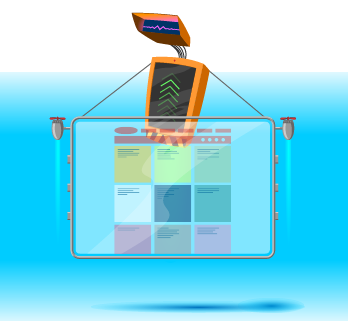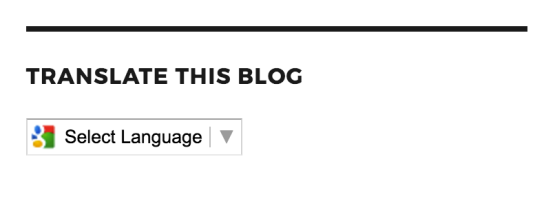Schema.org词汇表是最终的合作。
由于谷歌,微软,雅虎和Yandex之间的相互握手,我们有一个领域库,我们可以用来突出显示网页上的信息并更恰当地定义。通过利用结构化数据,我们为搜索引擎提供了更多的信心(即更好地理解页面内容),正如Alexis Sanders所解释的那样 在这个精彩的播客。这样做可以产生许多积极的影响,包括引人注目的SERP显示和改进的排名。
如果您是SEO,您对使用Schema.org词汇表审核或创建结构化数据标记有多大信心?如果您只是不舒服地换上了座位,那么这就是您的指南。在其中,我的目标是揭开JSON-LD的一些语法的神秘面纱,并分享有关为网页创建结构化数据的有用提示。
 理解JSON-LD的语法
理解JSON-LD的语法
虽然您可以通过几种不同的方式标记页面内容,但本指南将重点介绍Google更喜欢的格式; JSON-LD。此外,我们不会涉及其所有复杂性,而是最常遇到并且对SEO有用的那些实例。
大括号
开幕后你会注意到的第一件事 tag is an open curly brace. And, just before the closing 标签,一个封闭的大括号。

我们所有的结构化数据都将存在于这两个大括号中。当我们构建我们的标记时,我们可能会看到额外的花括号,这就是缩进真正有助于防止事情变得太混乱的地方!
引号
接下来你要注意的是引号。每次我们调用Schema类型,属性或填写字段时,我们都会将信息包装在引号中。

冒号
接下来是冒号(没有咯咯笑)。基本上,每次我们调用类型或属性时,我们都需要使用冒号继续输入信息。这是一个字段分隔符。

逗号
逗号用于设定另一个值(即更多信息)即将到来的期望。

请注意,填写“logo”属性的信息字段后,没有逗号。那是因为没有其他信息需要说明。
括号
当我们调用包含两个或更多条目的属性时,我们可以使用开括号和闭括号作为机箱。

了解我们如何在“sameAs”属性中包含Go Fish Digital的Facebook和Twitter个人资料?由于有多个条目,我们将两个条目括在括号内(我将其称为数组)。如果我们只包含Facebook网址,我们就不会使用括号。我们只需将值(URL)包装在引号中。
内花括号
每当我们调用具有预期“类型”的属性时,我们将使用内部花括号来封闭信息。

在上图中,调用了“contactPoint”属性。这个特殊的属性有一个预期的类型“ContactPoint”。这不是很好,令人困惑?稍后我们将详细介绍它,但现在请注意,在调用“contactPoint”属性后,会打开一个内部花括号。在下一行,您将看到调用的ContactPoint类型。声明了该类型中的属性(“telephone”和“contactType”),然后关闭了内部花括号。
在这个用例中还有其他一些东西,如果你现在能理解的话,将来会为你节省很多麻烦:
看看“客户服务”之后没有逗号。这是因为在该集合中没有更多信息可供共享。但是在封闭的内部大括号之后有一个逗号,因为有更多的数据要来(具体来说,“sameAs”属性)。
使用在线生成器创建结构化数据标记
现在我们对语法有了一点了解,让我们开始创建结构化数据标记。
如果您是初学者或作为创建基线标记以建立(并节省时间)的方法,在线生成器是很棒的。我最喜欢的是 Merkle的模式标记生成器,这是我将用于指南的这一部分的那个。
接下来,您需要选择页面和标记类型。在这个例子中,我选择了 https://gofishdigital.com/ 作为我们的页面和组织作为我们的标记类型。

填写一些信息后,我们的工具为主页创建了一些出色的基线标记:

希望在我们的语法课程之后,你可以毫无问题地阅读这个例子中的大部分(或全部)!
使用文本编辑器创建自定义结构化数据标记
基线标记会很好,但我们可以超越在线生成器预设,完全控制,并为我们的页面编写漂亮的自定义结构化数据。上 https://schema.org/Organization,您将看到属于组织标记类型的所有可用属性。这比在线工具提供的要多得多,所以让我们卷起袖子,遇到麻烦!
下载文本编辑器
此时,我们必须将训练轮放好并留下在线工具(单个撕裂)。我们需要一个可以编辑和创建自定义标记的地方。我不会对此感到温柔 – 得到一个 文本编辑器 现在。这物超所值,将为您提供远远超出结构化数据标记的服务。我将使用我最喜欢的文本编辑器Sublime Text 3。
专业提示:转到视图>语法> Javascript> JSON以适当地设置语法。
我已经将生成器中的一些基线组织标记粘贴到Sublime Text中。这是它的样子:

添加属性:简易模式
页面在 https://schema.org/Organization 具有组织类型的所有可用字段。我们的基线标记没有电子邮件信息,所以我查看了Schema页面并发现了:

第一列显示有一个电子邮件属性。得分了!我将在结束括号后添加一个逗号来设置更多信息的期望,然后我将添加“email”属性:

Schema.org上的第二列是“预期类型”。这一次,它表示“文本”,这意味着我们只需输入电子邮件地址即可。天哪,我很喜欢它。

让我们继续推动。我想确保我们的电话号码是此标记的一部分,所以让我们看看是否有一个属性…

答对了。预期的类型只是“文本”。我将在“email”属性之后添加一个逗号,并在“电话”中投入。在此示例中无需突出显示任何内容;我可以告诉你,它已经掌握了它。

添加属性:硬模式
接下来,我们将添加一个更复杂的属性 – “地址”属性。就像“电子邮件”和“电话”一样,让我们跟踪它 https://schema.org/Organization。

所以,我确实看到了“文本”,但我也看到了预期的“PostalAddress”类型。带有数据标记的游戏的名称是:如果你可以更具体,那就更具体。让我们点击“PostalAddress”,看看那里有什么。

我看到许多需要简单文本值的属性。让我们选择其中一些属性并添加我们的“地址”标记!

以下是我添加此标记的步骤:
- 在“电话”属性后放置逗号
- 称为“地址”属性
- 由于“address”属性具有预期的类型,我打开了内部花括号
- 称为“PostalAddress”类型
- 在“PostalAddress”类型中调用属性
- 封闭内花括号
你能从上面的图片中发现所有这些吗?如果是这样,那么恭喜你 – 你已经完成了硬模式!
创建一个复杂的数组
在我们关于括号的讨论中,我提到了一个数组。当属性(例如“sameAs”)具有两个或更多个条目时,可以使用数组。

这是一个简单数组的一个很好的例子。但有时我们必须创建复杂的数组。例如,Go Fish Digital有两个不同的位置。我们如何为此创建数组?

如果我们将其分解,这并不是那么复杂。在北卡罗来纳州的信息之后,你会看到一个封闭的内部花括号。我刚输入一个逗号,然后为Virginia位置添加了相同的类型(PostalAddress)和属性。由于为“地址”属性创建了两个条目,因此我将整个内容括在括号中。
使用@graph创建节点数组
2019年4月16日, Joost de Valk 从 Yoast 宣布Yoast SEO 11.0的到来,它拥有新的结构化数据标记功能。您可以在中查看更新的概述 这个帖子 从 这个视频。但是,我想更深入地了解Yoast正在利用的一种特殊技术,为搜索引擎提供非常有用的信息,连接标记:使用@graph创建节点数组(*人群喘气)。
代码打开“@graph”,然后打开括号,调用数组。这与上面标题为“创建复杂数组现在打开数组,你会看到一系列节点(或Schema类型):
- 组织
- 网站
- 网页
- BreadcrumbList
- 文章
- 人
我已将每个分开(见下文),以便您可以轻松查看阵列的组织方式。每个节点内都有很多属性,但真正的神奇之处在于“@id”。
在WebSite节点下,他们调用“@id”并声明以下URL: https://yoast.com/#website。后来,在他们建立了WebPage节点之后,他们说网页是其中的一部分 yoast.com 网站包含以下行:
“isPartOf”:{ “@ ID”:”https://yoast.com/#website“}。
这有多棒?他们建立了有关网站和特定网页的信息,然后在两者之间建立了联系。
Yoast在Article节点下做同样的事情。首先,在WebPage下,他们再次调用“@id”并将URL指定为 https://yoast.com/wordpress-seo/#webpage。然后,在文章下,他们告诉搜索引擎文章(或博客文章)是网页的一部分,代码如下:
“isPartOf”:{ “@ ID”:”https://yoast.com/wordpress-seo/#webpage“}
在阅读下面的标记时,请特别注意以下两点:
- 上面列出的6个节点,每个节点分开以更好地可视化
- “@id”和“isPartOf”调用,用于定义,建立和连接数组中的项目
Bravo,Yoast!
来源页面: https://yoast.com/wordpress-seo/
{"@context":"https://schema.org",
"@graph":(
{
"@type":"Organization",
"@id":"https://yoast.com/#organization",
"name":"Yoast",
"url":"https://yoast.com/",
"sameAs":(
"https://www.facebook.com/yoast",
"https://www.instagram.com/yoast/",
"https://www.linkedin.com/company/1414157/",
"https://www.youtube.com/yoast",
"https://www.pinterest.com/yoast/",
"https://en.wikipedia.org/wiki/Yoast",
"https://twitter.com/yoast"),
"logo":{"@type":"ImageObject",
"@id":"https://yoast.com/#logo",
"url":"https://yoast.com/app/uploads/2015/09/Yoast-Logo-Icon-120x120.png",
"caption":"Yoast"},
"image":{"@id":"https://yoast.com/#logo"}},
{
"@type":"WebSite",
"@id":"https://yoast.com/#website",
"url":"https://yoast.com/",
"name":"Yoast",
"publisher":{"@id":"https://yoast.com/#organization"},
"potentialAction":{"@type":"SearchAction",
"target":"https://yoast.com/?s={search_term_string}",
"query-input":"required name=search_term_string"}},
{
"@type":"WebPage",
"@id":"https://yoast.com/wordpress-seo/#webpage",
"url":"https://yoast.com/wordpress-seo/",
"inLanguage":"en-US",
"name":"WordPress SEO Tutorial u2022 The Definitive Guide u2022 Yoast",
"isPartOf":{"@id":"https://yoast.com/#website"},
"image":{"@type":"ImageObject",
"@id":"https://yoast.com/wordpress-seo/#primaryimage",
"url":"https://yoast.com/app/uploads/2008/04/WordPress_SEO_definitive_guide_FI.png",
"caption":""},
"primaryImageOfPage":{"@id":"https://yoast.com/wordpress-seo/#primaryimage"},
"datePublished":"2019-03-28T14:05:01+00:00",
"dateModified":"2019-04-11T12:24:14+00:00",
"description":"This is the ONLY tutorial you'll need to hugely increase your search engine traffic by improving your WordPress SEO. Want higher rankings? Read on!",
"breadcrumb":{"@id":"https://yoast.com/wordpress-seo/#breadcrumb"}},
{
"@type":"BreadcrumbList",
"@id":"https://yoast.com/wordpress-seo/#breadcrumb",
"itemListElement":(
{
"@type":"ListItem",
"position":1,
"item":
{"@type":"WebPage",
"@id":"https://yoast.com/",
"url":"https://yoast.com/",
"name":"Home"}},
{
"@type":"ListItem",
"position":2,
"item":{"@type":"WebPage",
"@id":"https://yoast.com/seo-blog/",
"url":"https://yoast.com/seo-blog/",
"name":"SEO blog"}},
{
"@type":"ListItem",
"position":3,
"item":{"@type":"WebPage",
"@id":"https://yoast.com/tag/wordpress/",
"url":"https://yoast.com/tag/wordpress/",
"name":"WordPress"}},
{
"@type":"ListItem",
"position":4,
"item":{"@type":"WebPage",
"@id":"https://yoast.com/wordpress-seo/",
"url":"https://yoast.com/wordpress-seo/",
"name":"WordPress SEO: the definitive guide"}})},
{
"@type":"Article",
"@id":"https://yoast.com/wordpress-seo/#article",
"isPartOf":{"@id":"https://yoast.com/wordpress-seo/#webpage"},
"author":{"@id":"https://yoast.com/about-us/team/joost-de-valk/#author",
"name":"Joost de Valk"},
"publisher":{"@id":"https://yoast.com/#organization"},
"headline":"WordPress SEO: the definitive guide",
"datePublished":"2019-03-28T14:05:01+00:00",
"dateModified":"2019-04-11T12:24:14+00:00",
"commentCount":"4",
"mainEntityOfPage":"https://yoast.com/wordpress-seo/#webpage",
"image":{"@id":"https://yoast.com/wordpress-seo/#primaryimage"},
"keywords":"Content SEO, Google Analytics, Mobile SEO, Security, Site Speed, Site Structure, Technical SEO, WordPress, Yoast SEO"},
{
"@type":"Person",
"@id":"https://yoast.com/about-us/team/joost-de-valk/#author",
"name":"Joost de Valk",
"image":{"@type":"ImageObject",
"@id":"https://yoast.com/#personlogo", "url":"https://yoast.com/app/uploads/2018/09/avatar_user_1_1537774226.png",
"caption":"Joost de Valk"},
"description":"Joost de Valk is the founder and Chief Product Officer of Yoast and the Lead Marketing & Communication for WordPress.org. He's a digital marketer, developer and an Open Source fanatic.",
"sameAs":(
"https://www.facebook.com/jdevalk",
"http://www.linkedin.com/in/jdevalk",
"https://twitter.com/jdevalk")}
)}
Troubleshooting your markup
With all these brackets, braces, and commas in play, mistakes can happen. So how do we detect and fix them?
Sublime Text error reporting
If you followed my pro tip above and set your syntax to JSON, Sublime Text will highlight certain errors for you.

Sublime Text has detected an error and made a highlight. It’s important to note that errors are “reported” in three ways:
- The error is the highlighted item.
- The error is somewhere on the highlighted line.
- The error is somewhere in a previous field.
In this case, it’s the third option. Did you spot it? There’s a missing comma after “info@gofishdigital.com.”
Honestly, this error reporting can be confusing at first, but you’ll quickly get used to it and will start pinpointing the mistake(s) fairly easily.
Google’s structured data tool error reporting
Go to https://search.google.com/structured-data/testing-tool > New Test > Code Snippet. Paste and run your code. If there is an error, this is what you’ll see:

Click the error report and the tool will highlight the field after the error. As you’ll see, the missing comma after “info@gofishdigital” has caused the tool to highlight “telephone.” The logic there is that without the comma, that line actually is the error. It makes logical sense, but can be confusing, so it’s worth pointing out.
Sublime Text’s “hidden” underscore feature
Validating structured data markup can be maddening, and every little trick helps. As your structured data gets more complicated, the number of sections and brackets and curly braces is likely to increase. Sublime Text has a feature you may not have noticed that can help you keep track of everything!

In the above image, I’ve placed my cursor on the first line associated with the “sameAs” property. Look closely and you’ll notice that Sublime Text has underscored the brackets associated with this grouping. If the cursor is placed anywhere inside the grouping, you’ll need those underscores.
I often use this feature to match up my brackets and/or curly braces to be sure I haven’t left any out or added in an extra.
Validating your structured data
Of course, the ultimate goal of all this error checking is to get your code to validate. The troubleshooting tips above will help you develop a bulletproof method of error checking, and that you’ll end up with the euphoric feeling that validated markup gives!

Using Google search for unique cases
The lessons and examples in this guide should provide a solid, versatile knowledge base for most SEOs to work with. But you may run into a situation that you’re unsure how to accommodate. In those cases, Google it. I learned a lot about JSON-LD structured data and the Schema vocabulary by studying use cases (some that only loosely fit my situation) and fiddling with the code. You’ll run into a lot of clever and unique nesting techniques that will really get your wheels spinning.
Structured data and the future of search
The rumblings are that structured data is only going to become more important in moving forward. It’s one of the ways Google gathers information about the web and the world in general. It’s in your best interest as an SEO to untie the knot of JSON-LD structured data and the Schema vocabulary, and I hope this guide has helped do that.






